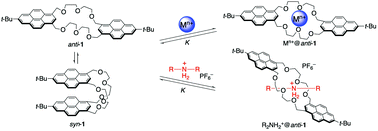当前位置:
X-MOL 学术
›
Photochem. Photobiol. Sci.
›
论文详情
Our official English website, www.x-mol.net, welcomes your
feedback! (Note: you will need to create a separate account there.)
(1,3)Pyrenophanes containing crown ether moieties as fluorescence sensors for metal and ammonium ions†
Photochemical & Photobiological Sciences ( IF 2.7 ) Pub Date : 2019-07-18 , DOI: 10.1039/c9pp00239a Hajime Maeda 1, 2, 3, 4, 5 , Keigo Nakamura 1, 2, 3, 4, 5 , Taniyuki Furuyama 1, 2, 3, 4, 5 , Masahito Segi 1, 2, 3, 4, 5
Photochemical & Photobiological Sciences ( IF 2.7 ) Pub Date : 2019-07-18 , DOI: 10.1039/c9pp00239a Hajime Maeda 1, 2, 3, 4, 5 , Keigo Nakamura 1, 2, 3, 4, 5 , Taniyuki Furuyama 1, 2, 3, 4, 5 , Masahito Segi 1, 2, 3, 4, 5
Affiliation

|
Crown ether containing (1,3)pyrenophanes 1–6 were synthesized, and UV absorption and fluorescence spectroscopic studies were carried out to determine their abilities to form complexes with metal and ammonium ions. The fluorescence spectra of 1.0 × 10−5 M solutions of 1, 2, 4 and 6 in 1 : 1 v/v CH2Cl2 : CH3CN were comprised of both monomer and intramolecular excimer emission bands, while only monomer emission bands were present in the fluorescence spectra of 3 and 5. The intensities of the intramolecular excimer emission bands of 1, 2, 4 and 6 in 1 : 1 v/v CH2Cl2 : CH3CN decreased and those of the monomer emission increased in conjunction with the existence of isoemissive points upon the addition of increasing concentrations of various metal perchlorates. The fluorescence spectral changes were dependent on the sizes of crown ether rings and metal ions and, as such, they reflected equilibrium constants for the formation of metal-crown ether complexes. Addition of n-Bu2NH2+PF6− or (PhCH2)2NH2+PF6− to the solutions of the (1,3)pyrenophane linked crown ethers, which brought about similar fluorescence spectral changes, led to the formation of pseudo-rotaxanes as was evidenced by an analysis of 1H NMR spectra and Job's plots. The fluorescence changes of 1 occurred during 5 cycles of repetitive addition and removal of Ba2+. The ratio of intensities of the monomer to the intramolecular excimer emission bands of 1, 2, 4 and 6 increased as the temperature decreased. Based on the experimental observations and the results of DFT calculations, it is concluded that the (1,3)pyrenophanes exist in solution as equilibrium mixtures of anti monomer emitting and syn intramolecular excimer emitting conformers and the equilibrium favors the anti form when the crown ether moieties form complexes with metal or ammonium ions.
中文翻译:

(1,3)含有冠醚部分的苯乙酮,可作为金属和铵离子的荧光传感器†
合成了含(1,3)邻苯二甲醚1-6的冠醚,并进行了紫外吸收和荧光光谱研究,以确定它们与金属和铵离子形成络合物的能力。为1.0×10的荧光光谱-5 M个解决方案1,2,4和6在1:1个的体积/体积CH 2氯2 :CH 3 CN中含有单体和分子内受激发射带的,而只有单体发射带在3和5的荧光光谱中存在。分子内准分子发射带的强度为1,2,4和6在1:1个的体积/体积CH 2氯2 :CH 3 CN降低,这些单体的排放结合isoemissive点的存在在加入增加各种金属高氯酸盐的浓度的增加。荧光光谱变化取决于冠醚环和金属离子的大小,因此,它们反映了形成金属-冠醚络合物的平衡常数。的加成Ñ -Bu 2 NH 2 + PF 6 -或(物理信道2)2 NH 2 +PF 6 -向(1,3)连接的pyrenophane冠醚的溶液,其带来的类似荧光光谱的变化,导致伪轮烷的形成作为通过的分析证明1个1 H NMR谱和工作的曲线图。在重复添加和去除Ba 2+的5个循环中发生了1的荧光变化。单体的强度的对的分子内受激准分子发射带的比率1,2,4和6随着温度降低而增加。基于实验观察和DFT计算结果,可以得出结论,存在于溶液中的(1,3)作为pyrenophanes的平衡混合物的抗单体发射和顺式分子内受激准分子发光的构象异构和平衡有利于反形式当冠醚部分与金属或铵离子形成络合物。
更新日期:2019-10-10
中文翻译:

(1,3)含有冠醚部分的苯乙酮,可作为金属和铵离子的荧光传感器†
合成了含(1,3)邻苯二甲醚1-6的冠醚,并进行了紫外吸收和荧光光谱研究,以确定它们与金属和铵离子形成络合物的能力。为1.0×10的荧光光谱-5 M个解决方案1,2,4和6在1:1个的体积/体积CH 2氯2 :CH 3 CN中含有单体和分子内受激发射带的,而只有单体发射带在3和5的荧光光谱中存在。分子内准分子发射带的强度为1,2,4和6在1:1个的体积/体积CH 2氯2 :CH 3 CN降低,这些单体的排放结合isoemissive点的存在在加入增加各种金属高氯酸盐的浓度的增加。荧光光谱变化取决于冠醚环和金属离子的大小,因此,它们反映了形成金属-冠醚络合物的平衡常数。的加成Ñ -Bu 2 NH 2 + PF 6 -或(物理信道2)2 NH 2 +PF 6 -向(1,3)连接的pyrenophane冠醚的溶液,其带来的类似荧光光谱的变化,导致伪轮烷的形成作为通过的分析证明1个1 H NMR谱和工作的曲线图。在重复添加和去除Ba 2+的5个循环中发生了1的荧光变化。单体的强度的对的分子内受激准分子发射带的比率1,2,4和6随着温度降低而增加。基于实验观察和DFT计算结果,可以得出结论,存在于溶液中的(1,3)作为pyrenophanes的平衡混合物的抗单体发射和顺式分子内受激准分子发光的构象异构和平衡有利于反形式当冠醚部分与金属或铵离子形成络合物。













































 京公网安备 11010802027423号
京公网安备 11010802027423号